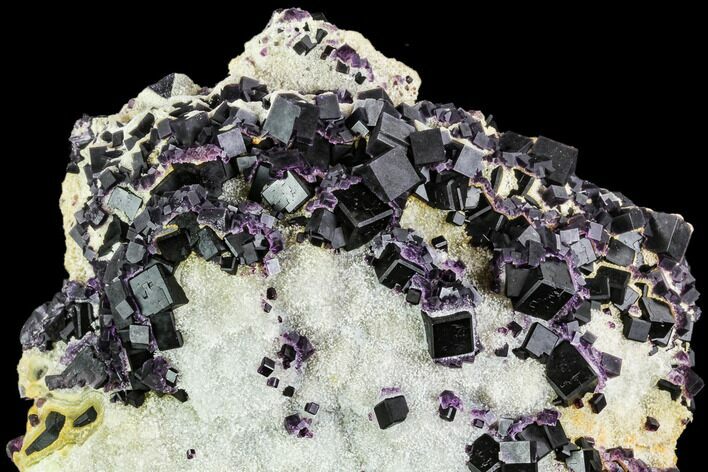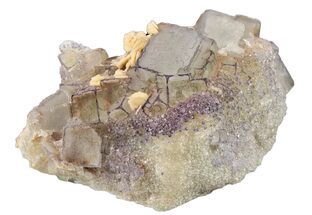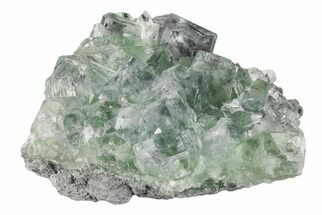This Specimen has been sold.
Phenomenal, 7" Dark Purple Cubic Fluorite Crystal Plate - China
This is a phenomenal association of dark purple, cubic fluorite crystals on/in quartz. Some of the fluorite crystals fluoresce under long wave UV, however the darker, more opaque crystals don't display much fluorescence, if any at all. The crystals are all in pristine condition, some of which have been cleared of the quartz aggregation that formed over them. These crystals formed in layers, rotating between layers of quartz and layers of fluorite. This formation pattern can be seen when viewing the underside of the specimen, where layers of both purple and green-blue fluorite can be found between layers of quartz.
This is truly a special specimen and it would make a wonderful addition to any mineral collection.
This is truly a special specimen and it would make a wonderful addition to any mineral collection.
About Fluorite
Fluorite is a halide mineral comprised of calcium and fluorine, CaF2. The word fluorite is from the Latin fluo-, which means "to flow". In 1852 fluorite gave its name to the phenomenon known as fluorescence, or the property of fluorite to glow a different color depending upon the bandwidth of the ultraviolet light it is exposed to. Fluorite occurs commonly in cubic, octahedral, and dodecahedral crystals in many different colors. These colors range from colorless and completely transparent to yellow, green, blue, purple, pink, or black. Purples and greens tend to be the most common colors seen, and colorless, pink, and black are the rarest.
Fluorite is a halide mineral comprised of calcium and fluorine, CaF2. The word fluorite is from the Latin fluo-, which means "to flow". In 1852 fluorite gave its name to the phenomenon known as fluorescence, or the property of fluorite to glow a different color depending upon the bandwidth of the ultraviolet light it is exposed to. Fluorite occurs commonly in cubic, octahedral, and dodecahedral crystals in many different colors. These colors range from colorless and completely transparent to yellow, green, blue, purple, pink, or black. Purples and greens tend to be the most common colors seen, and colorless, pink, and black are the rarest.
About Quartz
Quartz is the name given to silicon dioxide (SiO2) and is the second most abundant mineral in the Earth's crust. Quartz crystals generally grow in silica-rich environments--usually igneous rocks or hydrothermal environments like geothermal waters--at temperatures between 100°C and 450°C, and usually under very high pressure. In either case, crystals will precipitate as temperatures cool, just as ice gradually forms when water freezes. Quartz veins are formed when open fissures are filled with hot water during the closing stages of mountain formation: these veins can be hundreds of millions of years old.
Quartz is the name given to silicon dioxide (SiO2) and is the second most abundant mineral in the Earth's crust. Quartz crystals generally grow in silica-rich environments--usually igneous rocks or hydrothermal environments like geothermal waters--at temperatures between 100°C and 450°C, and usually under very high pressure. In either case, crystals will precipitate as temperatures cool, just as ice gradually forms when water freezes. Quartz veins are formed when open fissures are filled with hot water during the closing stages of mountain formation: these veins can be hundreds of millions of years old.
SPECIES
Fluorite & Quartz
LOCATION
China
SIZE
Plate 7 x 6.7", Largest cube .4"
CATEGORY
SUB CATEGORY
ITEM
#112058
 Reviews
Reviews
















